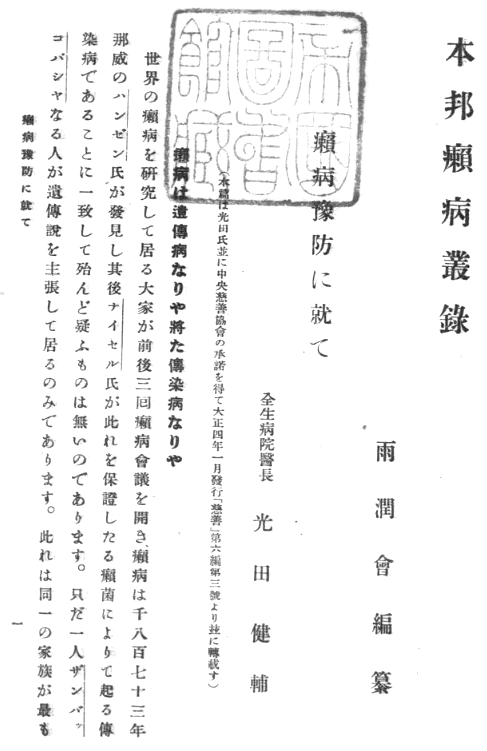小笠原登

小笠原登

| 小笠原登、ハンセン病の治療史関連 |
Noboru Ogasawara (小笠原 登, Ogasawara Noboru, July 10, 1888 – December 12, 1970) |
| 1873(明治6) ノルウェーのハンセ ンが癩菌を発見 1888 小笠原登、愛知県海部郡甚目寺村で生まれる。 1889(明治22)フランス人神父テストウィドが御殿場に復生病院を設立す る 1895(明治28)イギリス人ハンナ・リデルが熊本に回春病院を設立 1915 小笠原登、京都帝大を卒業、薬物学を研究 1925 小笠原登、専攻を皮膚泌尿器科 に転ず。 1925 小笠原、医学博士「ヌクレイン酸及びカゼインは家兎に於て腎臓を傷害す」 1926 らい治療を担当 1930「学会誌「レプラ」は大阪帝国大 学医学部皮膚科泌尿器科教室内(当時)の大阪皮膚病研究所から1930年に第1巻が発行された。その後1977年(第46巻)からは「日本らい学会雑 誌」、1996年(第65巻)からは「日本ハンセン病学会雑誌」と名称変更」(→出典) 1931「らいに関する三つの迷信」『診断と治療』18巻11号(1931年 11月) 1938 小笠原、京都帝国大学らいの診察・研究施設の皮膚科特別研究室主任 1941 小笠原、京都帝国大学助教授 1941 仏教系新聞『中外日報』が2月22日付で、小笠原の学説を「らいは不治でない。伝染説は全信できぬ」という題で紹介。早田晧(ひろし:1903 -1985)は、光田擁護の論陣を張り、小笠原を批判。 早田と小笠原の間では論争。大阪帝国大学医学部皮膚科の櫻井方策も小笠原を批判(→「佐谷有吉2代教授」)。 1941 11月第15回日本癩学会(大阪帝国大学微生物病研究所)で、小笠原「らい患者の心臓」について14日に発表:15日「野島泰治はらいの誤解を 解くという報告で小笠原を攻撃した。座長を務めた村田正太(まさたか)はらいを伝染病であるかと小笠原に質問した。らいは広義の伝 染病ではあるが誤解は起こさねばならぬ、と述べた。村田はそれに満足せず、伝染病であるかと再び問い、それは伝染病であるという言葉を聞くやそれでいい と、終了した[3]。その結果、小笠原が体質論を撤回したと受け止められ、朝日新聞と大阪毎日新聞は小笠原が論争に敗北したものとして報じた」ウィキ小笠 原登) 1947-1966 ハンセン病の治療に丸山ワクチンが利用された:「丸山が 国立療養所多磨全生園に通ってハンセン病患者の診療を続けていた1956年秋、患者が体内にライ菌を保持している間はがんの発生を抑えている[要出典]と いう事実を発見した。ライ菌と結核菌とは同じ好酸性の桿菌であることから、結核菌抽出物質の丸山ワクチンががん細胞の増殖を抑制できると考えた」 1948 小笠原、京都帝国大学を退官。豊橋病院 1955 7月小笠原、豊橋病院を退職 1957 9月国立療養所奄美和光園、園長?に就任(〜1966) 1966 10月小笠原、国立療養所奄美和光園を退官 1970 12月小笠原死去 1981 WHO(世界保健機関)の研究班によりリファンピシン、ダプソン、クロファジミンを同時併用する多剤併用療法(MDT)が開発 1991 第44回世界保健総会で、2000年末までに公衆衛生上の問題としてのハンセン病を制圧することが決議 1994 第1回国際ハンセン病制圧会議(於ハノイ)において、日本財団は1995年から1999年までの5年間でWHOに5,000万ドルを提供し、全 世界のハンセン病治療を必要とする人にMDTを無償で配布する計画を発表(→出典) |
Noboru Ogasawara
(小笠原 登, Ogasawara Noboru, July 10, 1888 – December 12, 1970) was a
Japanese physician (dermatologist) specializing in leprosy. He was an
assistant professor at the Department of Kyoto Imperial University. He
insisted that leprosy was not incurable and diathesis was an important
factor in the development of leprosy. He was against strict segregation
of leprosy patients and met strong opposition at a Congress of leprosy. Life: He was born in Jinmokuji Cho(Ama-shi in 2010), Aichi Prefecture on July 10, 1888. After graduating from Kyoto Imperial University, he studied pharmacology, and later dermatology. In 1926, he started the treatment of leprosy, and became the head of leprosy section in 1938. He became assistant professor in 1941. He treated many patients there on an outpatient basis. In 1948 he worked at Toyohashi Hospital. Between 1957 and 1966, he worked at Amami Wakoen Sanatorium, in Amami Island, Kagoshima Prefecture. He died on December 12, 1970 at his native town.[1] Three superstitions concerning leprosy:He wrote many papers and this was a representative paper.[2]; 1) There are three superstitions concerning leprosy and each has its reasons. The first superstition is it is incurable. This is because if the disease progresses to a some degree, it leaves deformities, never to become normal in appearance. I recently heard that they will form a leprosy prevention society and will give the patients happy recreations and happy life, and this is a project based on the incurability of leprosy. Religious superstitions are disturbing our treatment of leprosy. 2) The second superstition is that leprosy is a transmittable disease. We must learn that diathesis is important in the development of leprosy, since it is transmittable to people with a certain diathesis. 3) The third superstition is that leprosy is a vicious infection. This disease has been present from the early times of Japanese history, but the infected people have been so minimal, revealing that its infectivity is very mild. Heated debate in newspapers and at a congress of leprosy; In 1941, he made his opinions public in a newspaper called Chugai Nippou, and heated debate followed in the newspaper and Asahi Newspaper. At that time, the strict segregation policy was being taken by the state, and the "no leprosy patients in our prefecture" movement was in progress. Hiroshi Hayata, Hosaku Sakurai, both of the Kensuke Mitsuda school, attacked him. On November 14 and 15, there was heated debate between Ogasawara and scholars of the Mitsuda school. His speech was interrupted by a chairperson who stated Ogasawara admitted that leprosy was an infectious disease.[3] In Amami Ōshima; In 1956, he went to Amami Wakoen Sanatorium, a leprosy sanatorium on Amami Ōshima. He listened to the complaints of leprosy patients, and studied kanpo or traditional Chinese medicine. [1] Fujio Ohtani (1993), Hansen's disease Museum Noboru Ogasawara, Tofu Kyokai, Tokyo. in Japanese. [2] Three superstitions concerning leprosy, Ogasawara N. Shindan to Chiryo. 18, 11, 1931. [3] Inochi No Kindaishi,(2001) Fujino Y. Kamogawa Shuppan, Kyoto, p.301, The struggle of Dr. Ogasawara, In Japanese. |
■ハンセン病の隔離政策に反対した小笠原登(Noboru Ogasawara, 1880-1970)と光田派の抗争とその顛末
「1941 年2月22日、仏教系新聞『中外日報』が小笠原の学説を「らいは不治でない。伝染説は全信できぬ」という題で紹介した。彼はらい菌に遭遇して発病するが如 き体質が問題とすべきである、とした。この記事の登場は、当時らい医療の絶対的権威であった光田健輔ら療養所医師には黙認できないものであった。早田晧は 同じ新聞に小笠原への批判の文章を書いた。小笠原はこれに対し2回反論したが、早田は4回にわたり隔離を正当化する文章を書いた。朝日新聞も小笠原の学説 を紹介した。大阪帝国大学の桜井方策は小笠原の学説を朝日新聞で批判した。同年11月14日 - 15日、大阪帝大微生物学研究所で第15回日本らい学会が開かれた。初日小笠原は「らい患者の心臓」を発表、らいの発病条件は体質にあると述べた。2日 目、野島泰治はらいの誤解を解くという報告で小笠原を攻撃した。座長を務めた村田正太(まさたか)はらいを伝染病であるかと小笠原に質問した。らいは広義 の伝染病ではあるが誤解は起こさねばならぬ、と述べた。村田はそれに満足せず、伝染病であるかと再び問い、それは伝染病であるという言葉を聞くやそれでい いと、終了した」——引用はウィキペディアの「小笠原登(Noboru Ogasawara, 1880-1970)」よりだが、原出典は、 藤野豊 『「いのち」の近代史』による。
「光田派と真向から対立した小笠 原は、奄美和光園にいった。馬場園長が説得したといわれる。彼が奄美に到着した時は大西基四夫園長であった。和光園における彼は特に新しい治療法には関心 がなかったようで、漢方の研究をしていた。飄々としていた彼は、和光園の入所者の心の悩みを聞いたり、本土から奄美に流れ着いた日本画家田中一村と交わっ たりした。1965年6月25日、彼はらい事業功労者として表彰された。健康を害した彼は、荷物を置いたまま本土に旅だったが帰ってこなかった」これには 出典が不祥だが、引 用はウィキペディアの「小笠原登(Noboru Ogasawara, 1880-1970)」よりだが、原出典は、 藤野豊 『「いのち」の近代史』によるものであろう。
■国立ハンセン病療養所(全国に13箇所)——引用はウィキ「国立ハンセン病療養所」である。(今後の方針は「ハンセン病と癩(らい)を考えるページ」でおこないま す)
「国立ハンセン病療養所(こくりつハンセンびょうりょうようじょ)は、日 本の厚生労働省の施 設等機関である。全国に13施設ある。国立病院・療養所の多くは、2004年(平成16年)4月1日に独立行政法人国立病院機構へ、国立高度専門医療研究 センター(いわゆるナショナルセンター)は、2010年(平成22年)に独立行政法人に移行したが、国立ハンセン病療養所は、2016年(平成28年)現 在も、厚生労働省直属の施設機関である。主に、医療機関と元ハンセン病患者だった入所者が居住するコミュニティーで構成される。
| 松丘保養園 |
国立療養所松丘保養園(青森県) |
| 東北新生園 |
国立療養所東北新生園(宮城県) |
| 栗生楽泉園 |
国立療養所栗生楽泉園(群馬県) |
| 多磨全生園 |
国立療養所多磨全生園(東京都) |
| 駿河療養所 |
国立駿河療養所(静岡県) |
| 長島愛生園 |
国立療養所長島愛生園(岡山県) |
| 邑久光明園 |
国立療養所邑久光明園(岡山県) |
| 大島青松園 |
国立療養所大島青松園(香川県) |
| 菊池恵楓園 |
国立療養所菊池恵楓園(熊本県) |
| 星塚敬愛園 |
国立療養所星塚敬愛園(鹿児島県) |
| 奄美和光園 | 国立療養所奄美和光園(鹿児島県) |
| 沖縄愛楽園 | 国立療養所沖縄愛楽園(沖
縄県) |
| 宮古南静園 | 国立療養所宮古南静園(沖縄県) |
| 神山復生病院 | 民 間(静岡県御殿場) |
| 待労院診療所 | 民 間(熊本)2013年閉鎖 |
※なお、いくつか の国立療養所のHPのURLが2017年9月より変更する可能性があることが上掲のHPで告知されている。
文献
■光田健輔の戦前に出版したものはまがりなりにも読めるようになっている(国会図書館)——印影は【帝国図書館蔵】とある。雨潤会とは鎌倉
女学院とも縁のある古河潤吉の遺贈金からなる雨潤会基金から運営された団体/財団のようなものだろう。※古川潤吉(1870−1905)明治時代の鉱業
家。明治3年10月4日生まれ。陸奥(むつ)宗光の次男。古河市兵衛の養子。佐渡鉱山学校で採鉱冶金(やきん)学を,アメリカのコーネル大で化学と鉱山学
をまなぶ。古河の鉱山事業を改革,経営難の克服につとめた。明治38年12月12日死去。36歳。——コトバンクより)
